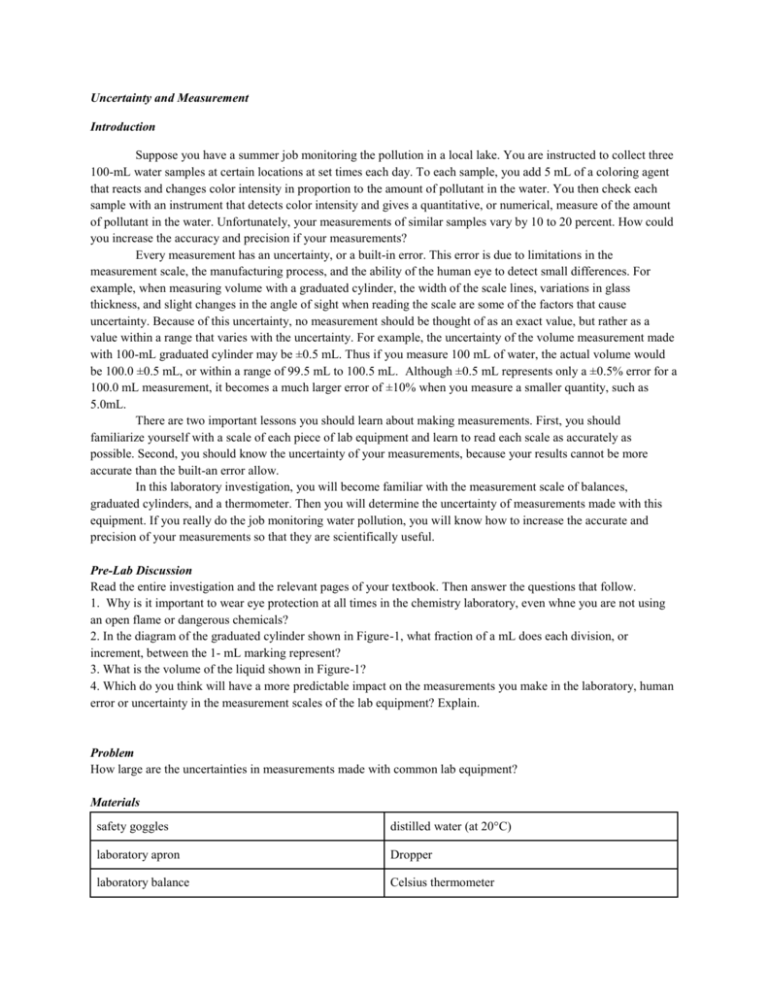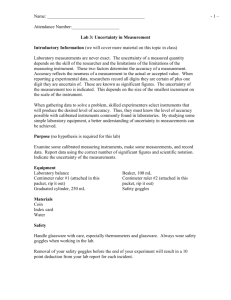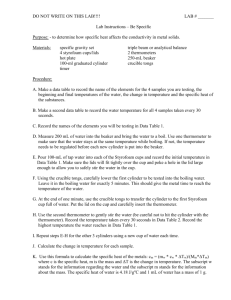Uncertainty in Measurement Lab
advertisement

Uncertainty and Measurement Introduction Suppose you have a summer job monitoring the pollution in a local lake. You are instructed to collect three 100-mL water samples at certain locations at set times each day. To each sample, you add 5 mL of a coloring agent that reacts and changes color intensity in proportion to the amount of pollutant in the water. You then check each sample with an instrument that detects color intensity and gives a quantitative, or numerical, measure of the amount of pollutant in the water. Unfortunately, your measurements of similar samples vary by 10 to 20 percent. How could you increase the accuracy and precision if your measurements? Every measurement has an uncertainty, or a built-in error. This error is due to limitations in the measurement scale, the manufacturing process, and the ability of the human eye to detect small differences. For example, when measuring volume with a graduated cylinder, the width of the scale lines, variations in glass thickness, and slight changes in the angle of sight when reading the scale are some of the factors that cause uncertainty. Because of this uncertainty, no measurement should be thought of as an exact value, but rather as a value within a range that varies with the uncertainty. For example, the uncertainty of the volume measurement made with 100-mL graduated cylinder may be ±0.5 mL. Thus if you measure 100 mL of water, the actual volume would be 100.0 ±0.5 mL, or within a range of 99.5 mL to 100.5 mL. Although ±0.5 mL represents only a ±0.5% error for a 100.0 mL measurement, it becomes a much larger error of ±10% when you measure a smaller quantity, such as 5.0mL. There are two important lessons you should learn about making measurements. First, you should familiarize yourself with a scale of each piece of lab equipment and learn to read each scale as accurately as possible. Second, you should know the uncertainty of your measurements, because your results cannot be more accurate than the built-an error allow. In this laboratory investigation, you will become familiar with the measurement scale of balances, graduated cylinders, and a thermometer. Then you will determine the uncertainty of measurements made with this equipment. If you really do the job monitoring water pollution, you will know how to increase the accurate and precision of your measurements so that they are scientifically useful. Pre-Lab Discussion Read the entire investigation and the relevant pages of your textbook. Then answer the questions that follow. 1. Why is it important to wear eye protection at all times in the chemistry laboratory, even whne you are not using an open flame or dangerous chemicals? 2. In the diagram of the graduated cylinder shown in Figure-1, what fraction of a mL does each division, or increment, between the 1- mL marking represent? 3. What is the volume of the liquid shown in Figure-1? 4. Which do you think will have a more predictable impact on the measurements you make in the laboratory, human error or uncertainty in the measurement scales of the lab equipment? Explain. Problem How large are the uncertainties in measurements made with common lab equipment? Materials safety goggles distilled water (at 20°C) laboratory apron Dropper laboratory balance Celsius thermometer standard masses heat-proof gloves 2 objects of unknown masses beaker containing boiling water graduated cylinder, 10-mL plastic tub graduated cyrlinder, 100-mL Ice Safety Wear your goggles and lab apron at all times during the investigation. Your eyes are fragile, and you should always protect them from potential laboratory hazards such as shattering glass or splashing boiling water. Procedure Part A: Estimating the Uncertainty of a Balance 1. Put on your goggles and lab apron. Obtain a laboratory balance and use the zeroing adjustment so the scale reads zero with no mass on the pan. Gently disturb the pan by touching it, and check to make sure that the balance returns to zero with no visible deviation. 2. Study the balance scale that has the smallest counterweight. Determine the mass increment size (in grams) represented by any one of the smallest scale divisions (between two adjacent marks), and record this value. Once you know this value, determine the mass represented by one half and one fifth of this scale increment. Record these vales. (Note: If you are using an electronic balance, skip this step.) 3. Obtain a standard and place it on the balance pan. Adjust the counterweights to find its mass. The mass should be equal or very close to the standard’s given value. Once the exact balance point is found, record the mass as accurately as the smallest scale increment allows (e.g., 10.00g) 4. Shift the smallest counterweight just slightly until you observe the slightest deviation from the zero point. The shift may be less than one scale division. Do the same for a shift in the opposite direction. These slightly lower and harder readings represent the apparent uncertainty range. Record the masses for the upper and lower ends, or limits, of the range. (Note: If you are using an electric balance, the apparent uncertainty is represented by the range between the higher and lower masses that may flicker on the display.) 5. As exactly as possible, record the mass of each of the two objects of unknown mass. Contribute your measurements to the class data bank for later use. While waiting for your turn with the two unknowns, you can proceed with part B of the investigation. Part B: Estimating the Uncertainty of Graduated Cylinders 6. Using the laboratory balance, measure and record the mass of a dry 10-mL graduated cylinder and a dry 100-mL graduated cylinder. CAUTION: If glass cylinders are being used, take care not to knock them over and break them. If a cylinder does shatter, do not pick up the broken pieces with your bare hands. 7. Record the volume represented by the smallest volume increment on each of the cylinders. Also determine and record the volume represented by one half and one fifth of the smallest volume increment. 8. Use a dropper to add 10.0 mL of distilled water to each cylinder. Add the last few drops to each cylinder carefully so that the bottom curve of the meniscus is on the 10.0-mL mark. 9. With the laboratory balance, measure and record the mass of each cylinder containing 10.0 mL of water. Part C: Estimating the Uncertainty of a Thermometer 10. Obtain a Celsius thermometer. Determine and record the temperature represented by the smallest scale increment. Also determine and record the temperature represented by one half and one fifth of the smallest scale increment. CAUTION: thermometers are fragile. Handle with care. 11. Put on a pair of heat-proof gloves and place the thermometer in the beaker of boiling water provided by your teacher. For 1 to 2 minutes, hold the thermometer in the boiling water so that the tip is not touching the beaker bottom. Remove the thermometer from the boiling water and quickly read it. Record the temperature, estimating to tenths of a degree. Contribute your measurement to the class data bank. CAUTION: Do not touch the beaker or hot plate with your bare hands. 12. Turn off the hot plate. Allow the thermometer to cool to room temperature. Then place it in a tub of ice water provided by your teacher. Leave the thermometer in the ice bath for 1 to 2 minutes. Record the temperature and contribute your measurement of the freezing point of water to the class date bank. 13. Return all equipment to the supply area. Clean up your work area and wash your hands before leaving the laboratory. Observations Part A: Laboratory Balance Smallest mass scale increment ________ One half of smallest mass scale increment ________ One fifth of smallest mass scale increment_______ Mass of standard weight ________ Mass of standard weight ________ Highest limit________ Lowest limit ________ Mass of unknown #1 _________ Mass of unknown #2_______ Part B: Graduated Cylinders Smallest volume scale increment One half of smallest volume scale increment One fifth of smallest volume scale increment Mass of empty cylinder Mass of cylinder with 10.0 mL of water Mass of 10.0 mL of water Part C: Thermometer Smallest temperature scale increment One half of smallest temperature scale increment One fifth of smallest temperature scale increment Temperature of boiling water Temperature of freezing water 10-mL _____ _____ _____ _____ _____ _____ 100-mL _______ _______ _______ _______ _______ _______ _________ _________ _________ _________ _________ Calculations Part A: Uncertainty for Laboratory Balance 1. Use your data for the mass of the standard weight to find the apparent uncertainty of your balance. Subtract the lower limit mass if the standard weight from the higher limit and divide this difference by 2. Round to one significant digit to get the apparent uncertainty (e.g., 0.0125 g rounds off to 0.01 g). Write the mass of the standard weight followed by the uncertainty (e.g., 10.00 g ± 0.01 g). 2. With classmates, evaluate the class measurement of the masses if the unknown. Discard any values that are much greater or much smaller than the majority of values. List and average the remaining masses for each unknown to find an average mass for each. 3. Determine the practical uncertainty for the lab balance by doing the following steps: a. To find the deviation in mass measurements for each unknown compute the difference (absolute value) between the average mass value (see answer to Question 2) and each of the mass measurements in the data list for Question 2. b. Average the list of mass deviations for each unknown and round to one significant figure (e.g., 0.012 g rounds off to 0.01 g). This is the practical uncertainty. Avg deviation (uncertainty) Unknown #1 ______ Unknown #2 ______ c. Report the average mass of each unknown followed by its uncertainty (e.g., 5.25 ± 0.01 g). Avg mass with uncertainty Unknown #1 ______ Unknown #2 _____ Part B: Uncertainty for Graduated Cylinders 1. With classmates, evaluate the class measurements of the masses of 10 mL of water. Discard and values that are much greater or much smaller than the majority of measurements. List the remaining measurements and compute an average mass for the water in each cylinder. 2. Determine the practical uncertainty of the mass measurements made in the 10-mL and the 100-mL graduated cylinders by doing the following steps: a. Take the difference (absolute value) between the avg mass of water and each individual mass of water in the data list for the 10-mL graduated cylinder. This gives a list of data deviations. Do the same for the 100-mL cylinder. b. Average the deviations for each cylinder and round to one significant digit (e.g., 0.133 g rounds off to 0.1 g). This practical uncertainty of the mass measurement is equivalent to the practical uncertainty of the cylinder volume because 1.00 g of water at 20°C has a volume of 1.00 mL Average deviation (uncertainty) 10 mL cylinder100mL cylinder c. Report the volume of water (10.0 mL) in each cylinder, followed by the calculated for each cylinder from Part B. Average volume with uncertainty 10-mL cylinder: 100-mL cylinder: Part C: Uncertainty of a Celsius Thermometer 1. With classmates, evaluate the class measurements of the boiling points and freezing points of water. Discard any values that are much higher or lower than the majority of temperature in each list. List the remaining temperatures and compute an average boiling point temperature and an average freezing point temperature. Class Data Bank: Water Temperature (°C) Boiling point Freezing point Avg boiling point ________ Avg freezing point______ 2. Determine the practical uncertainty of the thermometers by doing the following steps: a. Take the difference (absolute value) between the average boiling point and each boiling point in the data list. This gives a list of data deviations. Do the same with the average freezing point data. Deviations from Averages temperature (°C) Boiling Point Freezing Point b. Average the deviations for the boiling points and the freezing points and round to one significant figure. These are the practical uncertainties for the thermometers. Average deviation (uncertainty) Boiling Point ______________________ Freezing Point ____________________ c. Report the average boiling point and freezing point of water followed by the calculated uncertainty of each. Average boiling point with uncertainty Average freezing point with uncertainty ____________________________ ____________________________ Critical Thinking: Analysis and Conclusions 1. Why do students measuring the mass of the same object on similar balances report slightly different masses? 2. Which did you find to have a smaller uncertainty, the 10 mL or 100 mL graduated cylinder? Give a reason why one has a smaller uncertainty. 3. Based on your uncertainty determinations, tell whether balances or graduated cylinders appear to be more accurate measuring devices. 4. Assuming that the equipment was functioning properly, explain the probably source of error in data values that were discarded because of their large deviations. 5. Do the uncertainties you calculated for each type of lab equipment more closely match the size of the smallest scale division, one-half division, or one-fifth division? 6. Based on your answer to Question 5, what uncertainty would you assign to each type of equipment used? Balance ______________ 10 mL graduated cylinder ________ Thermometer __________ 100 mL graduated cylinder _______ Critical Thinking: Applications 1. If the uncertainty of a balance is ±0.005 g, how many significant figures would you use to report a scale reading when the counterweights lie exactly on the 8 gram mark? Explain your answer. 2. Suppose a students asks your advice about how to measure 9 mL of a liquid as accurately as possible using a graduated cylinder. Would you recommend a 10 mL or a 100 mL graduated cylinder? Support your answer using the results of the investigation. 3. What procedural change would you recommend to increase the accuracy and precision of the measurements discussed in the Introduction to this lab? Going Further 1. Determine the uncertainty of a carpenter’s tape measure, a tape measure used for sewing, or a measuring cup used for cooking. To make this determination, use methods similar to those used in this investigation. Present your findings to your class.









